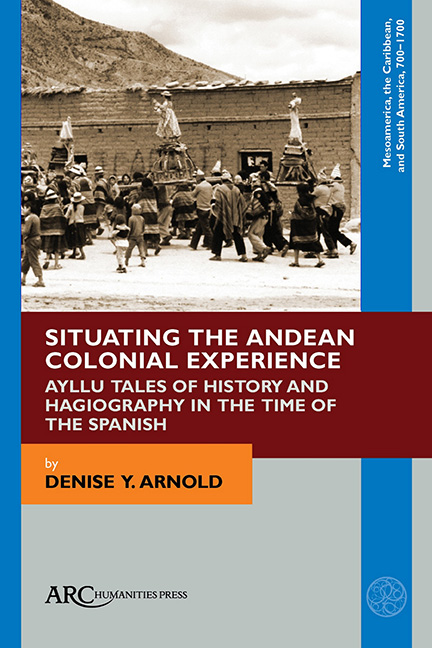 Situating the Andean Colonial Experience
Situating the Andean Colonial Experience Book contents
- Frontmatter
- Contents
- List of Illustrations
- Note About the Spelling of Toponyms and Proper Names
- Acknowledgements
- Maps
- Introduction
- PART ONE THE ORAL HISTORY OF QAQACHAKA
- PART TWO THE COLONIAL CACIQUES IN ORAL AND WRITTEN HISTORY
- PART THREE QAQACHAKA MARKA
- PART FOUR THE SAINTS APPEAR
- PART FIVE THE RELIGIOUS PRACTICES OF QAQACHAKA MARKA
- Some Conclusions
- Glossary
- Appendix A Document C of Don Franco Quispe Maraza
- Appendix B Document K of Don Franco Quispe Maraza
- Bibliography
- Thematic Index
- Index of Toponyms
Chapter 8 - From the History to the Hagiography of Qaqachaka
Published online by Cambridge University Press: 22 June 2021
- Frontmatter
- Contents
- List of Illustrations
- Note About the Spelling of Toponyms and Proper Names
- Acknowledgements
- Maps
- Introduction
- PART ONE THE ORAL HISTORY OF QAQACHAKA
- PART TWO THE COLONIAL CACIQUES IN ORAL AND WRITTEN HISTORY
- PART THREE QAQACHAKA MARKA
- PART FOUR THE SAINTS APPEAR
- PART FIVE THE RELIGIOUS PRACTICES OF QAQACHAKA MARKA
- Some Conclusions
- Glossary
- Appendix A Document C of Don Franco Quispe Maraza
- Appendix B Document K of Don Franco Quispe Maraza
- Bibliography
- Thematic Index
- Index of Toponyms
Summary
We order that there be another Cusco in Quito and another in Tumi (Pampa) and another in Guanaco (Pampa) and another in Hatun Colla and another in Charcas, and that the head shall be Cusco, and that those from the provinces be joined to the heads of the council and that it be law …
Hordenansas del Inga, in Guaman Poma (ca. [1612] 1988, fol. 185 (187). My translationAFTER ESTABL ISHING THE origins of the territories of Qaqachaka, and those of the first ancestors of the place, with their papers about the mining mit’a and the agricultural mit’a of the region, Don Franco continued his oral history with tales about the foundation of the main pueblo called Qaqachaka marka, in which he gave relatively more attention to the religious mit’a.
The etymology of the term marka in this context is not clear. In some precolonial toponyms, which are combined with the term marka, the use of this term seems to be Andean, for example in the well-known settlement of Caxamarka (or Cajamarca), derived from the Quechua Qasha marka, meaning “frozen pueblo” (marka is “pueblo” and qasha means “frozen”). However, the name Caxamarka is first mentioned by Spanish chroniclers, which suggests that the name might already have been changed from its original toponym. Further evidence of the Spanish origins of this term is given in Covarrubias's Tesoro of 1611, which locates the etymology of marca in the Roman occupation of Northern Europe, passing through Latin to medieval Spanish, to mean a new territory, distinct from those surrounding it.
Even so, there are still insistent arguments that the territory defined (or re-defined in the Colony) by this term had particular meanings for regional populations. With reference to the Inka period, the Polish linguist Jan Szemiński (1987b) proposes that marka was the territorial unit controlled by a specific wak’a, surrounded by agricultural and herding lands whose production was directed towards the ceremonial cycles focused upon the wak’a. The Chilean archaeologist Juan Chacama (2003) confirms this kind of ceremonial organization in Andean territories in general. So here we do have confirmation of certain meanings of marka from the perspective of local populations.
- Type
- Chapter
- Information
- Situating the Andean Colonial ExperienceAyllu Tales of History and Hagiography in the Time of the Spanish, pp. 161 - 182Publisher: Amsterdam University PressPrint publication year: 2021


